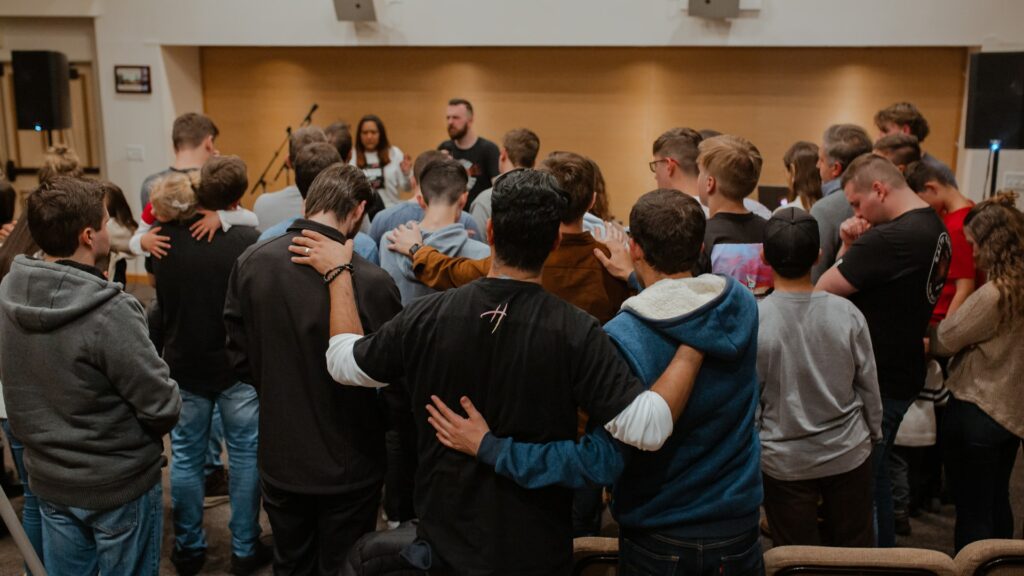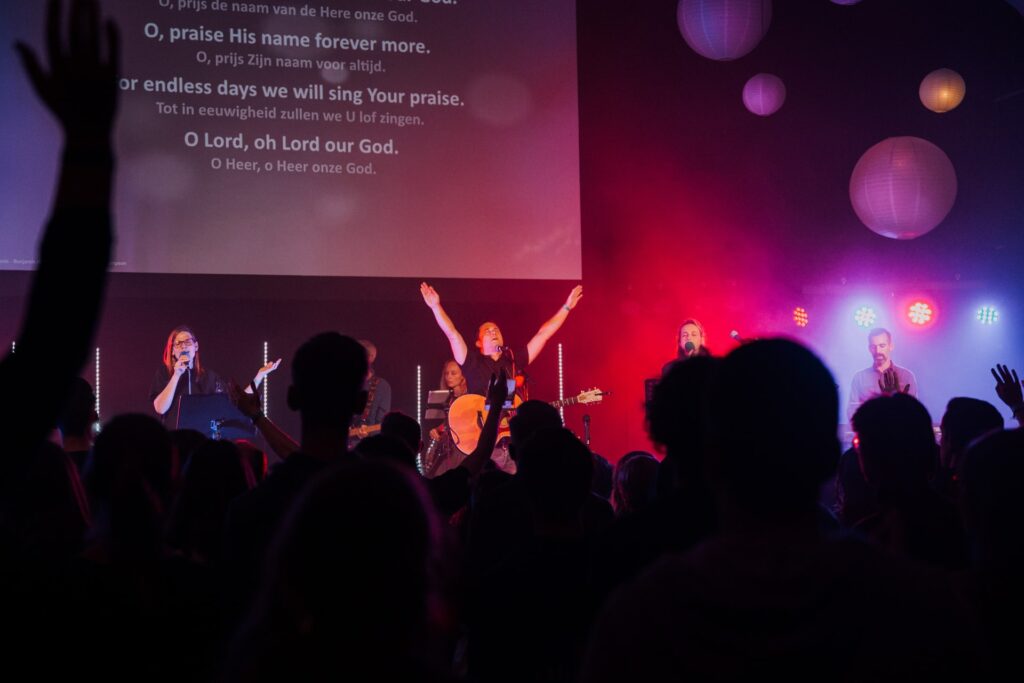Principles of Worship Leading – How To Lead Effectively
Rule Number One:
The Worship Leader must worship God with all his heart, soul, mind, and strength
Prepare the heart.
In preparing the heart to lead worship, a vision for worship is essential. My prayer is that by now your vision for worship has expanded beyond a “song service.” We must have a vision of His majesty. The critical phrase from Psalm 29 is “the glory due unto His name.” This is the biblical standard given to the worship leader. Until a leader has the vision of the majesty and glory of the Lord Jesus, he cannot be an effective worship leader. Throughout the Bible a transforming vision of God is the turning point in the lives of the leaders of God’s people from Abraham to Moses to David to Isaiah to Peter, James, John and to Paul. One of the greatest evidences of the resurrection of Jesus is the refusal of the witnesses who saw Him after His death to retreat from their vision of a risen Lord. A vision of Jesus our Sovereign is the goal of every praise and worship time.
Prepare the leaders.
The Lord must awaken a hunger and thirst for this vision of Jesus the King within the pastor, the board, the worship leader, the music department and the people. The pastor is the key personality. The church cannot go deeper into the presence of the Lord than the pastor will go. If he watches his watch during the praise and worship time, or talks to the person next to him, or studies his notes or is merely passive while the people are offering their sacrifices of praise, the church will never surmount the pastor’s personal obstruction.
To illustrate: a worship leader moved to a new church, one that was more involved in praise and worship than his previous church. At his former church, the revelation of God came through preaching not worship; worship was seen as an altar-time experience. The first time this man led worship in his new church he was amazed that so many of the people were worshiping God with all their might. After a few minutes the worship leader’s old instincts told him it was time to stop before this thing got out of hand. He stole a glance at the pastor to see if he was checking his watch. What he saw explained everything. The pastor had no thought of the time. His hands were spread out toward heaven and his head was thrown back with his eyes closed. A broad smile graced lips lost in the praise of His Redeemer.
 The worship leader then knew why the church was worshiping–the pastor was worshiping! And so it will always be. Wouldn’t it be wonderful if all pastors and guest speakers worshiped with all their might like King David. However some do not even come into the service until after the corporate praise and worship time, sending the message that it is really not that important, only a warm-up for the main event. Such non-verbal messages are hindrances to the revelation of Jesus through corporate worship.
The worship leader then knew why the church was worshiping–the pastor was worshiping! And so it will always be. Wouldn’t it be wonderful if all pastors and guest speakers worshiped with all their might like King David. However some do not even come into the service until after the corporate praise and worship time, sending the message that it is really not that important, only a warm-up for the main event. Such non-verbal messages are hindrances to the revelation of Jesus through corporate worship.
On the other hand, the worship leader must not go beyond the pastor’s vision for worship. Conflicts result when musicians are exposed to the kinds of biblical truths we have explored in this study but the pastor is not. When this is the case, the worship leader must be very careful. Usually the flow of theological instruction goes from pastor to staff member, and not the other way. Hopefully, two spiritual leaders can sit down and discuss Scripture and arrive at a mutual plan. The three questions posed in chapter one (Will I worship to please myself? others? or God?) will simplify the process. The heart of a true worshiper is a patient heart submitting to the pastor’s vision. God is never pleased if His truth is used to divide a church or to cause turmoil. The worship leader must never allow a “worship party” to form. God is not in political processes. A “party spirit” is something God hates.
How can a worship leader proceed if his pastor does not share his vision for worship? First, he must realize that worship is not his property. It is God’s. Second, he must realize no one knows better than God how to work in the pastor’s life. Remember that the true-hearted worship leader never touches the Lord’s anointed. Next, the worship leader must pray as he has never prayed before. It may be the Lord is doing something in his life that cannot happen in his current location. We must remember that God is not as wrapped up in our present situations as we tend to be He loves us more than He does our ministries. If he has birthed a ministry in our hearts, He will find a place for us to fulfill it. If He has called us to be a worship leader, He will find us a place where we can lead worship.
Prepare the people.
Together, the pastor, the board, and the worship leader must obey the command of Isaiah 40: “Make straight in the desert a highway for our God.” There may be valleys of insufficiencies that must be built up: insufficient vision for what true worship should be, insufficient understanding of how to go about worship, insufficient time (importance) given to worship, or, insufficient musical skills to release worship. There may be hindering mountains that have to come down: mountains of religious tradition, mountains of attitudes based upon cultural factors, mountains of musical or spiritual pride, mountains of false spirituality (fads, false teachings) or, mountains of insensitivity to the Holy Spirit on the part of those leading various parts of the service. Crooked places in the church procedures may need to be made straight: worship practices that are non-biblical; worship practices that are simply not anointed of God (yielding no supernatural results),or, worship practices that emphasize things neither spirit nor truth. The people may have grown used to rough places that need to be made smooth: careless service planning careless praise and worship planning, careless musicianship, careless treatment of the congregation by failing to provide words for songs, or, careless purchase and maintenance of instruments, materials, and facilities.
These types of hindrances can reach so deep into the life of the congregation that only a united effort by the pastor, the board, the worship leader, and the church musicians can root them out. Yet, this is exactly what is needed if the worship service is ever to be the highway of the Lord.
Prepare the sequence of songs.
The pastor and the worship leader must find God’s will for each service. God’s agenda for each service includes the songs (to be found by the worship leader) and the message (to be found by the pastor). Prayerful sensitivity during the week is the key. Just as the pastor must start thinking about the message before Saturday night, the worship leader should have the worship music close to his heart all week. In fact, the music of praise and worship needs to be a part of the worship leader’s daily life. Songs of praise, prayer, and worship should abide in his mind and dwell in his heart. He is constantly stocking his storehouse of new songs. Learning new hymns and choruses is his passion, making them a part of his private devotions long before they are given to the congregation. As early in the week as possible, if the pastor senses a certain theme or emphasis, he needs to point the worship leader that way.
 The song sequence should be worked out by midweek, at least. This means the leader has time to do some important things: prepare his heart to lead this set of songs through prayer and meditation; prepare materials needed to execute the plan; prepare the singers and instrumentalists and teach any new songs, and, refine the plan in consultation with the pastor. By preparing through the week the praise and worship plan becomes the prayerful product of the worship leader’s heart. It must establish and maintain a flow of worship and every element should be connected so that it flows together effortlessly.
The song sequence should be worked out by midweek, at least. This means the leader has time to do some important things: prepare his heart to lead this set of songs through prayer and meditation; prepare materials needed to execute the plan; prepare the singers and instrumentalists and teach any new songs, and, refine the plan in consultation with the pastor. By preparing through the week the praise and worship plan becomes the prayerful product of the worship leader’s heart. It must establish and maintain a flow of worship and every element should be connected so that it flows together effortlessly.
Two biblical illustrations of excellent preparation come to mind: the seamless robe of Jesus and Solomon’s Temple. The robe the soldiers gambled for was valuable because it was woven in one piece. If the Lord is to wear the robe of praise we prepare for Him, our motivations must be woven of one material: His glory, not ours. We are not showcasing our talents; we are honoring Him. We are not pumping up the people; we are praising the Lord. We are not performing for men’s applause; we are humbling ourselves before men, seeking God’s presence. The temple of Solomon was so well planned the workmen did not need to use the hammer or the iron tool to make the blocks of stone fit together. That is the way a praise and worship plan should be. For me, there have been times when things went wrong. Perhaps chords were mismatched among the keyboards or a transition was muffed. (Any number of things can go wrong!) The thought in my mind was “Oh, I just heard a hammer!” “Wow, I had to use an iron tool to get between those two songs! Forgive, me, Lord, I’ll plan it better next time!”
What makes praise and worship flow? Connections. Thoughts flow together when the last line of one song connects to the first line of the next. Thanksgiving flows into praise, which flows into worship. Moods flow together also: joy gives way to majestic wonder, which leads to reverent awe. Musically, the praise and worship will flow when songs are grouped together by their musical elements: key, tempo, and style. A praise and worship experience will flow if it has a destination.
The music of congregational praise and worship differs in this respect from the music of performance, even when that performance is ministered unto the Lord. Performance musicians are trained to surprise the listener with all sorts of musical devices: sudden modulations, sudden stops, rubato, fermatas, contrasts in style and tempo, and so forth. The purpose of these things is to keep the audience’s attention riveted to the performer. The goal of the worship musician is to point the listener’s attention to Jesus, not to himself. Therefore these elements must be used in ways that support the praise and worship, not detract from it. Music that is constantly jumping back and forth in tempo, or style, or constantly starting and stopping, or attempts to defy the natural flow of music from key to key will not flow as a corporate worship experience because it is constantly calling attention to itself. When ministering to the congregation, we can let our creativity and craftsmanship soar, but when ministering with the congregation, we must use our musical skill to facilitate the flow of the music. The skillful musician must be careful not to leave the congregation behind on his personal ascent of Mt. Zion.
A praise and worship experience will flow if it has a destination. Many times the pastor knows what should happen in the service and gives the worship leader a theme: missions, the Lord’s Supper, Prayer, and so on. Often, however, the worship leader must depend on the Lord for direction. God always knows what He wants to do in a service. Through the Holy Spirit we can be guided to the right ideas and find the songs to carry them. Through our musical understanding and our sensitivity to the Holy Spirit we can craft these songs and thoughts into a plan that God can use.
I will Outline My Process.
Planning worship
Planning worship is such an interplay of songs, truths and the personality of the worship leader that I hesitate to generalize as if all worship leaders plan the way I do, or that they should. I think of the models as basic guidance from the Holy Spirit. When I begin to plan the worship I will sometimes sense a desire to crown Jesus King among us, so I put together a set of songs that take us to the Throne Room. At other times I will sense that we should really celebrate the Lord’s presence so I put together a musical ascent of Mt. Zion to worship at David’s tabernacle. At still other times, I will sense the Lord’s desire to dwell with His people in the healing fullness of His holiness, and I will let thoughts of the Holy of Holies guide my selection of music. I think of what I am planning as the Living Sacrifice of Praise for the Holy-Royal Priesthood. On and on we can go through all the models. They serve this dual function: to help us understand worship and to guide our thinking as we plan worship.
the models as basic guidance from the Holy Spirit. When I begin to plan the worship I will sometimes sense a desire to crown Jesus King among us, so I put together a set of songs that take us to the Throne Room. At other times I will sense that we should really celebrate the Lord’s presence so I put together a musical ascent of Mt. Zion to worship at David’s tabernacle. At still other times, I will sense the Lord’s desire to dwell with His people in the healing fullness of His holiness, and I will let thoughts of the Holy of Holies guide my selection of music. I think of what I am planning as the Living Sacrifice of Praise for the Holy-Royal Priesthood. On and on we can go through all the models. They serve this dual function: to help us understand worship and to guide our thinking as we plan worship.
Many times the Lord impresses me first with how He wants the praise and worship time to end and I work toward that specific goal. At other times a certain chorus or hymn will be the definite starting point and I start connecting last lines to first lines, keys to keys, and styles to styles until I joyfully discover, song by song, where the Holy Spirit wants to take us. However God leads the worship leader, the worship plan is not something that is just thrown together at the last minute. The worship leader seeks and prepares it as a pastor would a Word from the Lord! It is a product of the worship leader’s devotional life, his sensitivity to the Holy Spirit, and his musicianship.
Communicate the plan.
A simple sheet of paper for each service should be provided to each singer, player, and technician who will help in the service. The number of things the leader can communicate with a one page outline of the service is amazing: keys, modulations, introductions, interludes, differing orchestrations on hymn stanzas, solos, anticipated transitions and repeats, anything that can be thought out ahead of time.
Execute the plan.
Leading in worship only begins with the plan. During the time of praise and worship in the service, the worship leader has to exercise sensitive leadership as the plan unfolds. It is at this point that he must walk a tightrope: he must worship God with all his might, but still be thinking ahead in the plan; he must give himself completely to the praise and worship of his God, but still gauge how the people are responding to the plan he is giving them; and, he must take charge of the musical aspects of the sequence (tempo, transitions, etc.) but never feel like he is making something happen. (Leading worship is a process of letting something happen, not making something happen.)
Steps To Worship Leading
- Prepare the heart,
- Prepare the leaders,
- Prepare the people,
- Prepare the songs (old and new)
- Communicate the plan,
- Execute the plan.
These things need to be in place for this to come about: the plan must be available to all who need it, and signals must be used and the words must be  provided. Use simple signals during the service. There are some things that cannot be planned ahead of time. The worship leader needs a set of signals. Again, let me share the ones I use as these are the only ones I can vouch for. Make eye contact with the pianist just before the next modulation in the plan. Because all the musicians have the plan, they are all looking for my signal as to the moment when we will do the modulation. The pianist makes sure the organist and the rhythm section know that the time is coming—and it happens! All from a written plan and a glance! I walk around quite a bit as I lead worship, so it is easy for me to give the signal without the congregation noticing. (I have had to work with the piano in all possible locations, behind me and to either side, but I have never had to abandon “the look” as a signal for the next modulation.)
provided. Use simple signals during the service. There are some things that cannot be planned ahead of time. The worship leader needs a set of signals. Again, let me share the ones I use as these are the only ones I can vouch for. Make eye contact with the pianist just before the next modulation in the plan. Because all the musicians have the plan, they are all looking for my signal as to the moment when we will do the modulation. The pianist makes sure the organist and the rhythm section know that the time is coming—and it happens! All from a written plan and a glance! I walk around quite a bit as I lead worship, so it is easy for me to give the signal without the congregation noticing. (I have had to work with the piano in all possible locations, behind me and to either side, but I have never had to abandon “the look” as a signal for the next modulation.)
A signal for a transition is needed.
I put my right hand in the air and all the musicians know I am about to conduct something. I conduct all transitions, getting the tempo changes I want or creating pauses between songs. (I do not conduct all during praise and worship. Once a tempo is set, there is no need to beat it out. In this way, when I need to conduct something, my gestures have meaning.)
A “last time” or code signal is needed so the musicians can know when the last time through a song is upon them, especially if there is a special ending. I use my right fist in the air. All of the signals only work if players are watching. With their utmost attention given to the worship leader, such signals can be discreet. The whole congregation should not be distracted by the signals used by the worship leader.
People cannot be expected to sing songs if they do not know the words.
As an act of invitation and courtesy, provide the words. The old ways of singing from memory do not serve the growing church of today. When there aren’t a lot of new people coming to the church each week is little need to provide words for the home folk. When new people are coming to houses of worship, some were not raised in church. They may not even know the words to “Amazing Grace!”. In an effort to reach out to them and make them feel welcome, we must provide words on all the songs we sing, new or old.
aren’t a lot of new people coming to the church each week is little need to provide words for the home folk. When new people are coming to houses of worship, some were not raised in church. They may not even know the words to “Amazing Grace!”. In an effort to reach out to them and make them feel welcome, we must provide words on all the songs we sing, new or old.
Pastor Gifford (of the Wichita church I served in the early 1980’s) said this of memorized singing, “It makes the visitors feel like they are on the outside looking in, as if we were saying to them, ‘See all the neat songs we know! If you stay here long enough, you can learn our songs, too, and then you can join us.’” This is not the message the worship leader wants to send.
On the other hand, if we provide the words to all our songs, we are saying, “We’re glad you are here. We love to sing unto the Lord. Many of our songs may be new to you but we want you to join us and sing!” This is the message of the effective worship leader.
The songs themselves have changed today; there are more of them and they are more complex than those of yesterday. To do justice to the songs we select requires visual help. Today’s songs have much more content and much less repetition; words are needed. God always has music for each stage of growth through which He takes the church. New songs soar on the winds of revival. They are the life of the praise and worship of the church.
A balance of old and new songs is best as we learn to value all anointed songs.
Those who by nature love the new songs must learn to appreciate the old songs. Those who love the old songs must learn to respect the new songs. New songs are a command of Scripture but Scripture also says for one generation to declare God’s works to the next. Previous generations have left us their songs! Older songs still have much to say and their use can be enhanced by projecting of words as well. Old and new, songs that exalt the Lord, edify the body and flow decently and in order are works of the Holy Spirit and should be esteemed as such.
Dr. Steve Phifer received a Doctorate in Worship Studies from the Robert E. Webber Institute for Worship Studies. He has taught at Valley Forge University and Southeastern Assemblies of God University. For many years he was the Worship Pastor at Word of Life Church in Alexandria, VA.
More of Dr. Phifer’s materials can be found at stevephifer.com.
